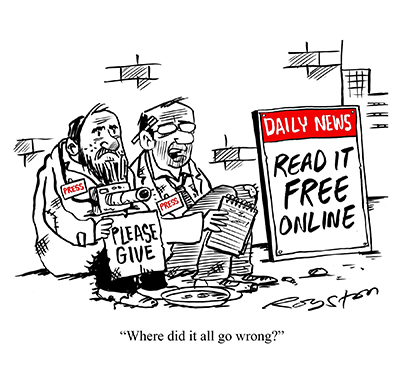 According to publishing consultant Peter Houston of Flipping Pages Media, by now we should all pretty much agree that paid content is the future of the news media. There’s a caveat, however.
According to publishing consultant Peter Houston of Flipping Pages Media, by now we should all pretty much agree that paid content is the future of the news media. There’s a caveat, however.
“Recognizing the strategic advantage of re-establishing a reader revenue stream and having a reader revenue stream are two very different things,” Houston writes in Publishing Executive. “One calls for a little common sense, the other is going to take some effort.”
Specifically, Houston believes that it will take a solid focus in three specific areas to convert free readers to paying one:
- Demonstrate quality
- Leverage data to shorten the sales cycle; and
- Add value to sweeten the pitch
“The more unique the content package, and the stronger your brand,
the less content you need to give away for free before people buy in.”
We’re seeing plenty of evidence the consumers are indeed willing to pay for news content – providing they see the value in it. According to Jason Schwartz in Politico, “millennials are subscribing to legacy news publications in record numbers—and at a growth rate, data suggests, far outpacing any other age group.”
The challenge lies in convincing someone that your content is worth paying for. And it can be done, Houston insists.
“The UK’s Financial Times, with its focus on a narrow business niche and a subscriber base dominated by corporate accounts, gives next to nothing away. It does let prospects sample content through a heavily discounted time-limited trial and famously boosted subscription sales 600% by opening access to its coverage of the UK’s Brexit referendum. But generally, nothing.”
And while quality content does the heavy lifting, it’s helped by savvy data use, in particular reader behavior data.
“Like the WSJ, Hearst Newspapers is testing technology to automatically flex paywall access and target subscription promotions depending on reader behaviors and preferences. Content access is opened or closed depending on data signals, from location and device to the type of content the customer has shown an interest in.”
Beyond the content and the data, there’s some good, common sense marketing going on, too, making prospects feel special.
“Increasingly publishers are adding extras to clearly differentiate their subscriber offering from the user experience that is available for free,” Houston explains. Access to members-only content, early access, and other perks are driving revenue too.
There’s no magic formula here, and what works for the publishers cited in the piece might not work for your. And that’s okay. Houston quotes FIPP’s John Wilpers, writing in their Innovation in Magazine Media report, as saying:
“If it is valued, if it is unique, if it is something you can’t get anywhere else, and if it speaks to their passions, makes them smarter, gives them advantages, and entertains them, then much like everything else that does that, readers should pay for it.”
All things considered, it hasn’t taken publishers long to stop chasing a future that doesn’t exist. Instead, they are realizing that readers are willing to pay for quality content.
“Your job as a seller of content is to convince your audience that that what they are buying is unique, useful and entertaining,” Houston concludes. “Then, once you’ve signed them up, all you need to do is deliver.”

August 16, 2018, 7:42 am